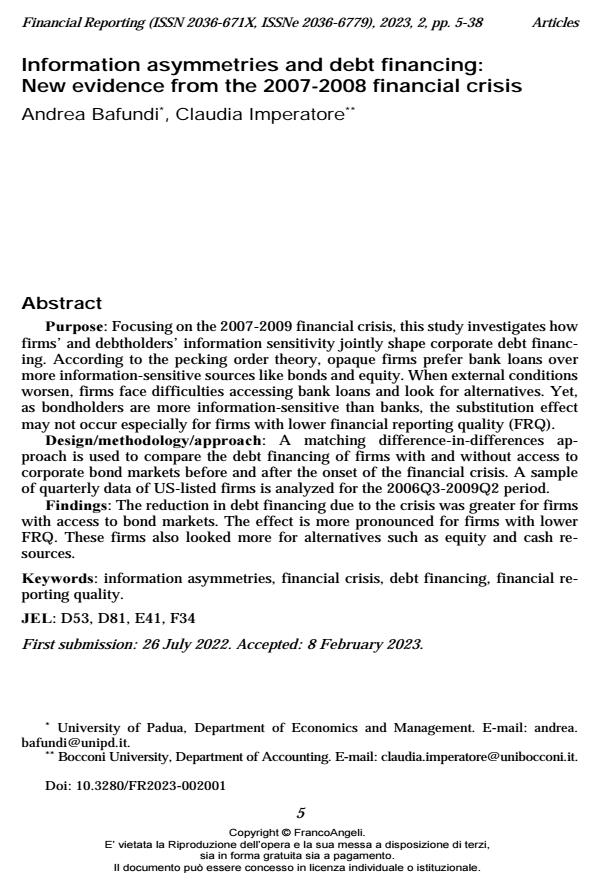Information asymmetries and debt financing: New evidence from the 2007-2008 financial crisis
Titolo Rivista FINANCIAL REPORTING
Autori/Curatori Andrea Bafundi, Claudia Imperatore
Anno di pubblicazione 2023 Fascicolo 2023/2
Lingua Inglese Numero pagine 34 P. 5-38 Dimensione file 221 KB
DOI 10.3280/FR2023-002001
Il DOI è il codice a barre della proprietà intellettuale: per saperne di più
clicca qui
Qui sotto puoi vedere in anteprima la prima pagina di questo articolo.
Se questo articolo ti interessa, lo puoi acquistare (e scaricare in formato pdf) seguendo le facili indicazioni per acquistare il download credit. Acquista Download Credits per scaricare questo Articolo in formato PDF

FrancoAngeli è membro della Publishers International Linking Association, Inc (PILA)associazione indipendente e non profit per facilitare (attraverso i servizi tecnologici implementati da CrossRef.org) l’accesso degli studiosi ai contenuti digitali nelle pubblicazioni professionali e scientifiche
Purpose: Focusing on the 2007-2009 financial crisis, this study investigates how firms’ and debtholders’ information sensitivity jointly shape corporate debt financing. According to the pecking order theory, opaque firms prefer bank loans over more information-sensitive sources like bonds and equity. When external conditions worsen, firms face difficulties accessing bank loans and look for alter-natives. Yet, as bondholders are more information-sensitive than banks, the substi-tution effect may not occur especially for firms with lower financial reporting qual-ity (FRQ). Design/methodology/approach: A matching difference-in-differences ap-proach is used to compare the debt financing of firms with and without access to corporate bond markets before and after the onset of the financial crisis. A sample of quarterly data of US-listed firms is analyzed for the 2006Q3-2009Q2 period. Findings: The reduction in debt financing due to the crisis was greater for firms with access to bond markets. The effect is more pronounced for firms with lower FRQ. These firms also looked more for alternatives such as equity and cash re-sources.
Parole chiave:information asymmetries, financial crisis, debt financing, financial re-porting quality.
Jel codes:D53, D81, E41, F34
- The dynamics of cost behavior: Unveiling sticky costs in private companies Nicola Dalla Via, in FINANCIAL REPORTING 2/2024 pp.13
DOI: 10.3280/FR2024-002002 - Does leverage create or destroy value in the long run? A re-examination of Nissim and Penman (2001) Antonio De Vito, Lorenzo Dal Maso, Patrizia Petrolati, Noemi Pecoraro, in FINANCIAL REPORTING 2/2024 pp.47
DOI: 10.3280/FR2024-002003
Andrea Bafundi, Claudia Imperatore, Information asymmetries and debt financing: New evidence from the 2007-2008 financial crisis in "FINANCIAL REPORTING" 2/2023, pp 5-38, DOI: 10.3280/FR2023-002001